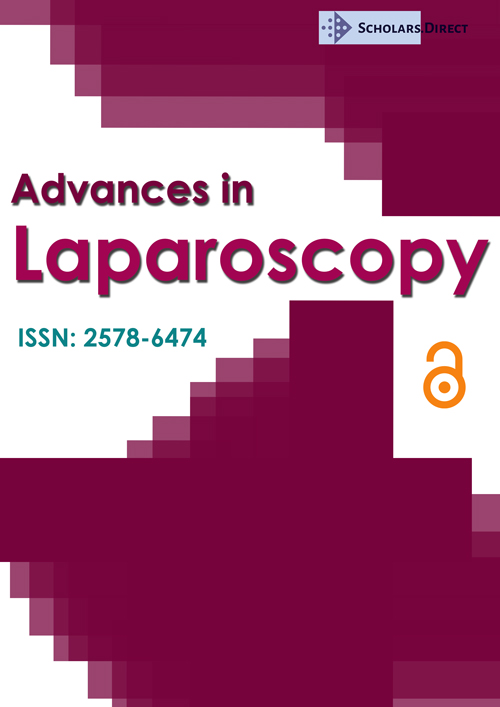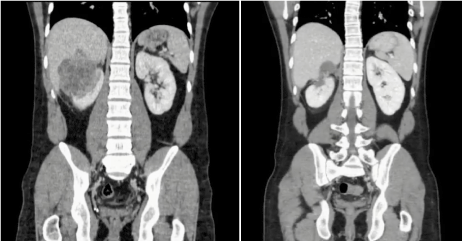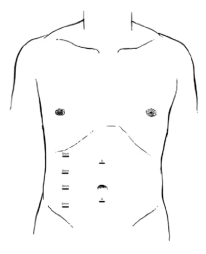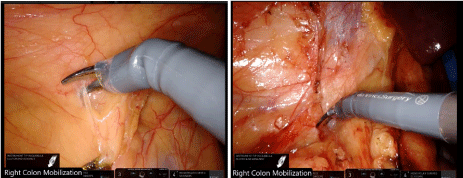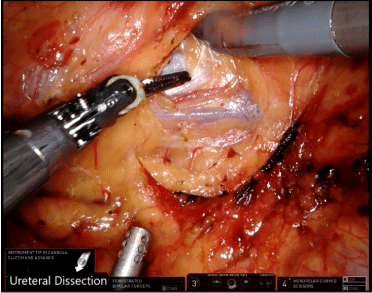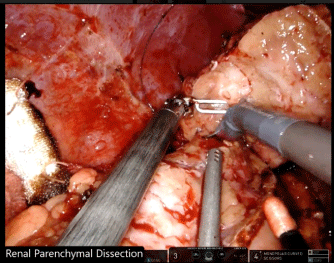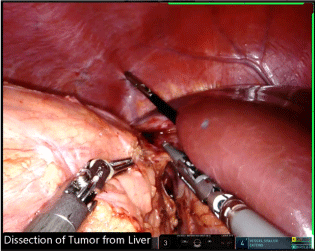Safety and Feasibility of Robotic-Assisted Partial Nephrectomy and Partial Hepatectomy for Soft Tissue Sarcoma
Abstract
Background: This study is the first to describe the use of a robot-assisted nephron-sparing technique for a enbloc resection of a complex Ewing's sarcoma of the right kidney invading the liver.
Objectives: To demonstrate robot-assisted laparoscopic hepatobiliary resections of soft tissue tumors are both feasible and safe.
Design, Setting, and Participants: A twenty-seven year old male presented with stage 3B, non-osseous Ewing's Sarcoma of the right kidney invading the liver. He received three cycles of vincristine, doxorubicin, cyclophosphamide/ifosfamide, etoposide (VDC/IE) pre-operatively and four post-operatively at two week intervals. A multivisceral resection using a robot-assisted technique was performed to remove the liver-kidney mass enbloc using a nephron-sparing technique without conversion to open surgery. Surgical margins were negative for malignancy and no blood transfusion was needed. The patient tolerated the procedure well, was extubated and transferred to the recovery room in a hemodynamically stable condition. The patient was monitored in the intensive care unit until postoperative day (POD) one. He did not require any blood transfusion postoperatively. By POD three, he was tolerating a full liquid diet and was on oral pain medication. He was discharged on POD three. Pathology showed a large, necrotic, hemorrhagic, fibrotic focus with negative surgical margins. Surveillance CT scan at postoperative month 3 showed no evidence of recurrent disease. Surveillance CT scan at postoperative month 9 confirmed no recurrence of disease.
Conclusions: Complex oncologic robotic multivisceral resections can be safely performed in select patients in centers with surgical expertise and multidisciplinary care. Additionally, it is amenable to management of Ewing sarcoma.
Patient Summary: We describe a novel application for robot-assisted multivisceral resection, with successful outcome, on a soft tissue sarcoma. We conclude that robotic assisted surgery is both safe and feasible for tumors involving multiple organs.
Keywords
Hepatic, Robotic, Resection, Minimally invasive surgery
Introduction
Minimally invasive liver surgery (laparoscopic& robotic) offers faster recovery time [1,2] with equivalent surgical and oncologic outcomes [3] compared to open liver surgery for primary and metastatic liver cancer [4,5]. In 2008, the feasibility, safety, and indications of laparoscopic liver resection was first established [6]. Since then, there have been no large-scale studies evaluating robot-assisted laparoscopic surgery for the extirpation of tumors involving multiple organs. The literature suggests that robotic liver resections could be an advantageous technique that may facilitate accurate tissue resection of lesions adjacent to major vessels, close to the liver hilum, or in difficult anatomic positions [7].
Similarly, robotic kidney resections may allow prompt initiation of adjuvant chemotherapy postoperatively [8]. This is in addition to the general benefits of robotic surgery including superior ergonomics and visualization [9], which expand the scope of minimally invasive procedures and the population of patients who benefit. Recently, robot-assisted multivisceral resections have been described for liver metastasis in pancreatic neuro endocrine tumors [10], colonic adeonocarinoma [11], rectal carcinoma [12], and renal cell carcinoma [11]. Robot-assisted multivisceral resections have also been described for synchronous primary tumors with partial resection of a renal malignancy [13-22]. We present the first case of robot-assisted partial right nephrectomy and partial hepatectomy for Ewing sarcoma of the kidney. In doing so, we demonstrate that multivisceral resections can be safely performed and confer the benefits of minimally invasive surgery to a broader patient population.
Case Presentation
The patient is a twenty-seven year old male presented with stage 3B, non-osseous Ewing's Sarcoma of the right kidney invading the liver. He was diagnosed via image-guided biopsy after a 10 cm right renal mass abutting liver segment six was discovered on CT of the abdomen and pelvis (Figure 1a). He received three cycles of vincristine, doxorubicin, cyclophosphamide/ifosfamide, etoposide (VDC/IE) preoperatively (Figure1b) and four postoperatively at two-week intervals. Preoperative course was complicated by right internal jugular vein deep venous thrombosis which was treated with rivaraxoban 20 mg. Following a pre-operative evaluation, informed consent was obtained. A multivisceral resection using a robot-assisted technique was then performed to remove the liver-kidney mass using a nephron-sparing technique without conversion to open surgery. Surgical margins were negative for malignancy and no blood transfusion was needed. The patient tolerated the procedure well, was extubated and transferred to the recovery room in a hemodynamically stable condition. He was closely monitored in the ICU before transfer to the hospital floor on POD one. The patient was discharged on POD three, 24 hours after a febrile episode. Postoperative surgical pain was transitioned from IV to oral pain meds when appropriate with the assistance of supportive medicine. CT of the abdomen and pelvis at three months postoperatively showed no evidence of recurrent disease. CT at nine months postoperatively showed no evidence of disease. The patient remained disease-free nine months postoperatively.
Methods/Procedures
After informed consent was obtained, the patient was given perioperative antibiotics prior to the procedure. After general anesthesia was obtained the patient was placed in the lateral decubitus position, right side up at 90%.Veress needle in sufflation was achieved and a linear robotic trocar configuration was utilized for the Da Vinci Xi robot: A standard 8mm camera port, an 8 mm left hand port and an 8mm right hand port were placed at the midclavicular line in a linear configuration. A 12 mm air seal assist port along with a 5 mm assist port were placed closer to the midline in a linear fashion (Figure 2). After the robotic interface was assembled, the white line Toldt was incised and the duodenum kocherized exposing the IVC. The coronary ligament was incised to expose the right kidney and obtain mobility of the liver (Figure 3a and Figure 3b).
The ureter and gonadal vein were exposed inferiorly (Figure 4) and the ureter was lifted anterolaterally to expose the renal hilum. The posterior plane behind Gerota's fascia and the kidney was dissected off the psoas and held up by the fourth robotic arm. The renal hilum was dissected to expose a single renal artery and two renal veins. The accessory renal vein was divided with a vascular load stapler. The upper pole of the kidney was then exposed to reveal the location of the tumor. Following ultrasound location of the mass, the renal artery was clamped and the tumor was dissected off of the kidney using a nephron-sparing approach with an ischemia time of 21 minutes and total operation time of 300 minutes (Figure 5). Next, the partial hepatectomy was performed. Ultrasound guidance demonstrated tumor involvement of segment six of the liver. The liver parenchyma was scored with cautery to expose the borders of the tumor and the tumor was transected using the robotic vessel sealing device. The right triangular ligament was then released later on which finally released the mass onto the surface of the kidney (Figure 6). The raw surface area of the liver was then cauterized. and a single layer of synthetic hemostatic agent was placed along the raw surface area to obtain hemostasis. The kidney was closed in two layers and bioglue was placed on the resection site.
Discussion
We present a case of robot-assisted laparoscopic partial nephrectomy and partial hepatectomy. In this case, a retroperitoneal Ewing's sarcoma of the right kidney invading the liver was resected using a robot-assisted laparoscopic nephron-sparing technique. Favorable post-surgical and oncologic outcomes were achieved using this technique. Appropriate patient selection is critical for robot-assisted multivisceral resections. Poor oncologic prognosis of patients affected by malignant tumor represents an important incentive to adopt some minimally invasive operation that is able to minimize the perioperative comorbidity [23]. Konstantinidis, et al. [11] describe subjective advantage of minimally invasive surgery for elderly (due to single-stage procedure) and morbidly obese patients (due to minimized wound morbidity). Furthermore, Imagami T, et al. [8] and Morelli L, et al. [24] provide a rationale behind a single stage procedure, decreased length of stay and post-operative morbidity.
It is also noteworthy that avoiding a delayed second surgery may improve oncologic outcomes due to earlier administration of adjuvant chemotherapy [13]. We propose that this approach be utilized for smaller tumors that are not in close proximity to the renal vessels and involve only one segment of the liver, as was the case with the present patient. We describe a novel case of robot-assisted multivisceral resection for a primary renal tumor metastatic to the liver not previously described in the literature. Similarly, however, few robot-assisted multivisceral resections involving partial nephrectomy have been described in the literature for synchronous primary tumors of various abdominopelvic organs. A robot-assisted partial nephrectomy and partial hepatectomy was described by Ong, et al. [21] for synchronous renal cell and hepatocellular carcinoma. Piccoli M, et al. [13] describe the first full-robotic nephrectomy/colorectal resection in two patient patients.
Both the first patient (right colectomy with right partial nephrectomy) and second patient (anterior rectal resection with left partial nephrectomy) had an uneventful post-operative course and were discharged on POD 9 and POD 10 respectively without cancer recurrence at 12 month follow-up. Six papers describe robot-assisted partial nephrectomy and radical prostatectomy. Patient outcomes were not described in the case reported by Guttilla A, et al. [14]. Akpinar C, et al. [19] and Patel MN, et al. [15] described no evidence of residual renal cancer and undetectable PSA at three-month and four-month follow-up respectively. Oncologic outcomes described in Raheem AA, et al. [16] mention negative surgical margins and discharge on POD four. Jung JH, et al. [18] describe a lack of recurrence of renal cancer and PSA of 0.51 ng/ml at two-month follow-up. Jung JH, et al. [20] also describe a series of three patients with a median length of stay of seven days, a positive surgical margin in one patient, urethral injury with subsequent ureteroneocystosomy in another patient.
No other adverse outcomes were described at 18-month follow-up. Kim J, et al. [17] discussed a case of robot-assisted gastrectomy and partial nephrectomy with no evidence of late complications or recurrence at six-month follow-up. Robot-assisted multivisceral resections of tumors offer reduced perioperative morbidity [10-12,25]. Similarly, favorable outcomes after either robot-assisted partial nephrectomy [26] or radical nephrectomy [27] secondary to Ewing Sarcoma have been described in the literature. To our knowledge, this is the first application of robot-assisted multivisceral resection using a nephron sparing approach for Ewing Sarcoma with favorable oncologic and surgical outcomes.
Conclusion
Robotic-assisted multivisceral resection is a feasible and safe option. The literature suggests improved perioperative outcomes of minimally invasive techniques when compared to open yet similar outcomes for laparoscopic and robot-assisted techniques. Technically advanced procedures involving multiple organs may be successfully performed with robot-assisted surgery due to increased visualization, surgical range of motion, and enhanced ergonomics. Although more studies are needed to evaluate postoperative outcomes, this study demonstrates that robotic assisted surgery is both safe and feasible for tumors involving multiple organs.
References
- Ciria R, Cherqui D, Geller DA, et al. (2016) Comparative short-term benefits of laparoscopic liver resection: 9000 cases and climbing. Ann Surg 263: 761-777.
- Chen PD, Wu CY, Hu RH, et al. (2017) Robotic versus open hepatectomy for hepatocellular carcinoma: A matched comparison. Ann Surg Oncol 24: 1021-1028.
- Tsung A, Geller DA, Sukato DC, et al. (2014) Robotic versus laparoscopic hepatectomy: A matched comparison. Ann Surg 259: 549-555.
- Takahara T, Wakabayashi G, Beppu T, et al. (2015) Long-term and perioperative outcomes of laparoscopic versus open liver resection for hepatocellular carcinoma with propensity score matching: A multi-institutional Japanese study. J Hepatobiliary Pancreat Sci 22: 721-727.
- Beppu T, Wakabayashi G, Hasegawa K, et al. (2015) Long-term and perioperative outcomes of laparoscopic versus open liver resection for colorectal liver metastases with propensity score matching: A multi-institutional Japanese study. J Hepatobiliary Pancreat Sci 22: 711-720.
- Buell JF, Cherqui D, Geller DA, et al. (2009) The international position on laparoscopic liver surgery: The Louisville Statement, 2008. Ann Surg 250: 825-830.
- Abood GJ, Tsung A (2013) Robot-assisted surgery: Improved tool for major liver resections? J Hepatobiliary Pancreat Sci 20: 151-156.
- Imagami T, Takayama S, Hattori T, et al. (2018) Combined laparoscopic and robotic surgery for synchronous colorectal and genitourinary cancer: A case series. Int J Surg Case Rep 51: 323-327.
- Giulianotti PC, Bianco FM, Daskalaki D, et al. (2016) Robotic liver surgery: Technical aspects and review of the literature. Hepatobiliary Surg Nutr 5: 311-321.
- Calin ML, Sadiq A, Arevalo G, et al. (2016) The first case report of robotic multivisceral resection for synchronous liver metastasis from pancreatic neuroendocrine tumor: A case report and literature review. J Laparoendosc Adv Surg Tech A 26: 816-824.
- Konstantinidis IT, Raoof M, Zheleva V, et al. (2019) Multivisceral robotic liver surgery: Feasible and safe. J Robot Surg 14: 503-507.
- Xu JM, Wei Y, Wang XY, et al. (2015) Robot-assisted one-stage resection of rectal cancer with liver and lung metastases. World J Gastroenterol 21: 2848-2853.
- Piccoli M, Pecchini F, Esposito S, et al. (2020) First cases of combined full robotic partial nephrectomy and colorectal resections: Results and new perspectives. Int J Med Robot 16: e2131.
- Guttilla A, Crestani A, Zattoni F, et al. (2012) Combined robotic-assisted retroperitoneoscopic partial nephrectomy and extraperitoneal prostatectomy. First case reported. Urologia 79: 62-64.
- Patel MN, Eun D, Menon M, et al. (2009) Combined robotic-assisted laparoscopic partial nephrectomy and radical prostatectomy. JSLS 13: 229-232.
- Raheem AA, Santok GD, Kim DK, et al. (2016) Simultaneous Retzius-sparing robot-assisted radical prostatectomy and partial nephrectomy. Investig Clin Urol 57: 146-149.
- Kim J, Kim SM, Seo JE, et al. (2014) Concurrent robot-assisted distal gastrectomy and partial nephrectomy for synchronous early gastric cancer and renal cell carcinoma: An initial experience. J Gastric Cancer 14: 211-214.
- Jung JH, Arkoncel FRP, Lee JW, et al. (2012) Initial clinical experience of simultaneous robot-assisted bilateral partial nephrectomy and radical prostatectomy. Yonsei Med J 53: 236-239.
- Akpinar C, Suer E, Turkolmez K, et al. (2019) combined robotic-assisted laparoscopic radical prostatectomy and partial nephrectomy, Rare coincidence. Urology 128: 1-4.
- Jung JH, Kim HW, Oh CK, et al. (2014) Simultaneous robot-assisted laparoendoscopic single-site partial nephrectomy and standard radical prostatectomy. Yonsei Med J 55: 535-538.
- Ong KH, Huang SKH, Yen CS, et al. (2016) Simultaneous retroperitoneal robotic partial nephrectomy and hepatectomy for synchronous renal-cell carcinoma and hepatocellular carcinoma in a cirrhotic patient. J Endourol Case Rep 2: 215-217.
- Boncher N, Vricella G, Greene G, et al. (2010) Concurrent robotic renal and prostatic surgery: Initial case series and safety data of a new surgical technique. J Endourol 24: 1625-1629.
- Goldfarb M, Brower S, Schwaitzberg S (2010) Minimally invasive surgery and cancer: Controversies part 1. Surg Endosc 24: 304-334.
- Morelli L, Di Franco G, Guadagni S, et al. (2017) Full robotic colorectal resections for cancer combined with other major surgical procedures: Early experience with the da Vinci Xi. Surg Innov 24: 321-327.
- Smith N, Murphy D, Lawrentschuk N, et al. (2020) Robotic multivisceral pelvic resection: Experience from an exenteration unit. Tech Coloproctol 24: 1145-1153.
- Suzuki I, Kubota M, Murata S, et al. (2019) A case of Ewing sarcoma family tumor of the kidney treated with robotic-assisted partial nephrectomy. Urology case reports 25: 100900.
- Miao C, Yang J, Xue J, et al. (2018) Renal Ewing sarcoma/primitive neuroectodermal tumor in a pregnant woman who underwent robot-assisted laparoscopic nephrectomy: A case report and literature review. Onco Targets Ther 11: 6839-6843.
Corresponding Author
Pooya Banapour MD, City of Hope National Medical Center, Department of Surgery, Duarte, 11411 Brookshire ave #506, Downey, CA 90241, USA; Tel: 562-923-0706, Fax: 409-205-0891.
Copyright
© 2022 Odeluga N. This is an open-access article distributed under the terms of the Creative Commons Attribution License, which permits unrestricted use, distribution, and reproduction in any medium, provided the original author and source are credited.

